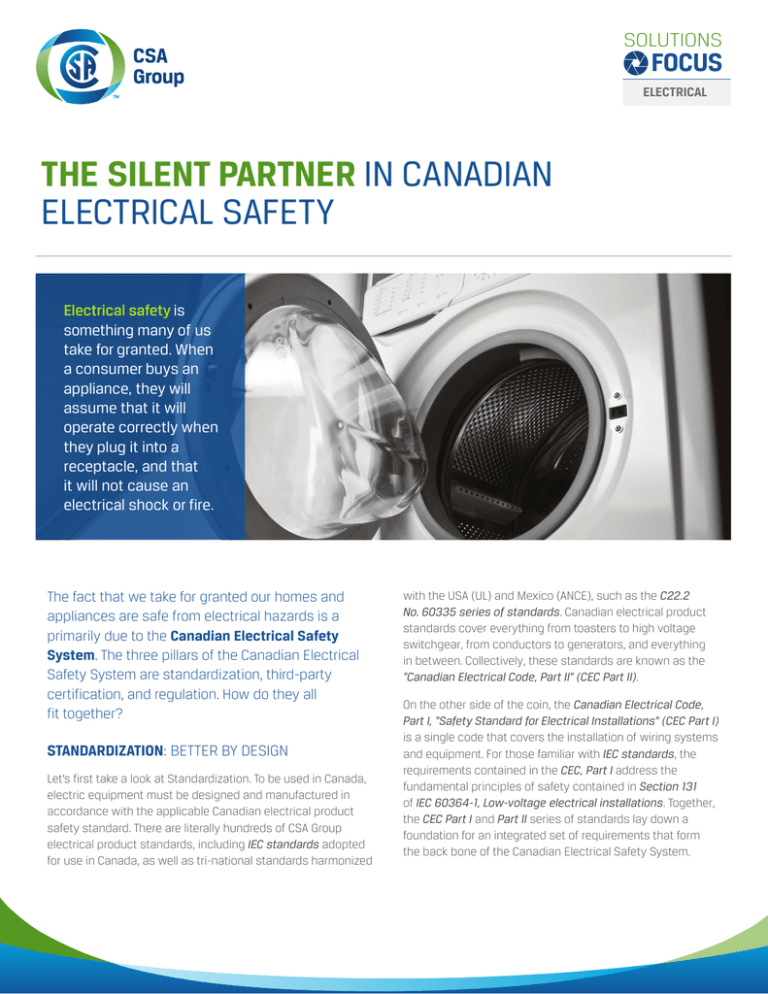THE SILENT PARTNER IN CANADIAN ELECTRICAL SAFETY
advertisement

SOLUTIONS FOCUS ELECTRICAL THE SILENT PARTNER IN CANADIAN ELECTRICAL SAFETY Electrical safety is something many of us take for granted. When a consumer buys an appliance, they will assume that it will operate correctly when they plug it into a receptacle, and that it will not cause an electrical shock or fire. The fact that we take for granted our homes and appliances are safe from electrical hazards is a primarily due to the Canadian Electrical Safety System. The three pillars of the Canadian Electrical Safety System are standardization, third-party certification, and regulation. How do they all fit together? STANDARDIZATION: BETTER BY DESIGN Let’s first take a look at Standardization. To be used in Canada, electric equipment must be designed and manufactured in accordance with the applicable Canadian electrical product safety standard. There are literally hundreds of CSA Group electrical product standards, including IEC standards adopted for use in Canada, as well as tri-national standards harmonized with the USA (UL) and Mexico (ANCE), such as the C22.2 No. 60335 series of standards. Canadian electrical product standards cover everything from toasters to high voltage switchgear, from conductors to generators, and everything in between. Collectively, these standards are known as the “Canadian Electrical Code, Part II” (CEC Part II). On the other side of the coin, the Canadian Electrical Code, Part I, “Safety Standard for Electrical Installations” (CEC Part I) is a single code that covers the installation of wiring systems and equipment. For those familiar with IEC standards, the requirements contained in the CEC, Part I address the fundamental principles of safety contained in Section 131 of IEC 60364-1, Low-voltage electrical installations. Together, the CEC Part I and Part II series of standards lay down a foundation for an integrated set of requirements that form the back bone of the Canadian Electrical Safety System. REGULATION: LEVELING THE PLAYING FIELD The third pillar of the Canadian Electrical Safety System is regulation. Inspectors enforcing electrical safety regulations are at the front line of the Canadian Electrical Safety System as they are often the first to encounter unsafe installation practises or products. The fact that every single regulatory authority in Canada has a voting position on Canadian Electrical Code Committees means that they can immediately bring issues to the attention of the responsible code or standards committee. It also means that the resulting changes are coordinated and developed through a consensus process together with their fellow regulators and other industry stakeholders, the outcome of which is a set of electrical safety requirements that is largely consistent among Canadian Provinces and Territories. Consistent, nationally adopted, safety regulations remove barriers to inter-provincial labour mobility and trade, and create a unified level national playing field for designers and contractors within all Provinces and Territories. There are some common misconceptions associated with identifying who is responsible for regulating electrical safety in Canada. First of all it should be understood that electrical safety is not regulated by CSA Group, by Standards Council Canada, or by the Federal Government of Canada. In Canada, electrical safety regulation is the responsibility of the Provinces and Territories. The one exception is for premises that are federally owned or regulated. This includes airports, post office buildings, federal buildings, military installations, and similar facilities. Although the provinces and territories do not have jurisdiction over federal installations, the federal government will often direct their contractors to comply with local codes and obtain permits and inspections from the local authority having jurisdiction. The CEC, Part I and its referenced series of CEC, Part II standards are adopted as regulation by all Provinces and Territories, and through bylaws enacted by municipalities having authority for electrical inspection such as the cities of Winnipeg, Victoria, and Calgary. CEC, Part I is also referenced by the Federal Government through the Canadian Labour Code. While standardization, certification, and regulation are the foundation of the Canadian Electrical Safety System, safety doesn’t just simply “happen”. It also requires trained electricians, dedicated educators, skilled designers, diligent inspectors, knowledgeable manufacturers, worker safety organizations, and many other stakeholder groups. Understanding the connections between each pillar of the Canadian Electrical Safety System is the first step. ABOUT THE CANADIAN ELECTRICAL CODE Developed by committees of experts representing a broad spectrum of industry stakeholders from across Canada, the Canadian Electrical Code, Part I is published on a three year cycle and adopted as regulation in all Provinces and Territories. The 23rd edition of the CE Code will be published in January 2015 and features major revisions to several sections. ABOUT THE AUTHOR OF THIS ARTICLE Tim Pope, C.E.T. is a Senior Project Manager in the electrical standards program and is responsible for the Canadian Electrical Code, Part I. ABOUT CSA GROUP CSA Group is an independent, not-for-profit member-based association dedicated to advancing safety, sustainability and social good. We are an internationally-accredited standards development and testing & certification organization. We also provide consumer product evaluation and education & training services. Our broad range of knowledge and expertise includes: industrial equipment, plumbing & construction, electro-medical & healthcare, appliances & gas, alternative energy, lighting and sustainability. The CSA mark appears on billions of products around the world. For more information about CSA Group visit www.csagroup.org. JUNE 2014




